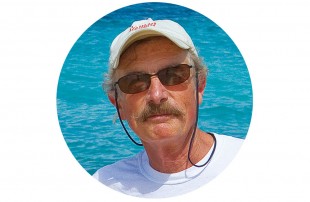Remedial education has its benefits ... even for a reluctant student

I had to check the proofs of this page extra carefully, lest some snarky editor garnish this column with the headline, “Ancient mariner goes back to school.”
It’s true, I did go back to school, but it wasn’t my idea. I had no choice. I felt like a plumber who had mastered the art of unplugging bathroom fixtures and other skills of his trade through decades of hands-on experience, but was told he had to go to vocational school for certification to continue his life’s work.
I went to school because starting this year the Chicago Yacht Club’s Race to Mackinac requires at least half of a boat’s crew, including the person in charge (PIC), to be a graduate of an approved safety-at-sea course.
As a PIC who was homeschooled in sailing safety but lacked a diploma, I matriculated at US Sailing College this spring—actually US Sailing’s online Safety at Sea course. Friends who had taken the course told me I probably already knew most of what it taught. That proved to be true (though some of the medical information was new to me), but even so the course was worth my time and I’m glad I invested in it, even if it was done sort of at gunpoint.
That’s because regardless of how much you know, it is good to reprocess the accumulated knowledge of dealing with emergencies on the water, especially at a time when safety at sea has become highly technical. Once it was intuitive, earned through experience and common sense and, for those lucky enough to possess it, good judgment. Now it requires some study to take full advantage of the many safety assets available.
You know, all those initials: AIS, GPS, DSC, PLB, EPIRB, PFD. All but one set translate to whiz-bang space-age communication—instant transmission of the location of mariners who need help. The exception is the last, personal flotation devices, the 21st-century iterations of life vests. The invention of the inflatable PFD has made life vests the linchpin of sailing safety.
This is revolutionary change. Before that invention, life vests were pretty much irrelevant to sailing safety. I’m sorry if this causes sworn members of the PFD Police to come down with symptoms of mal de mer, but it’s a fact: Many a sailor, no matter the hair-raising nature of his or her adventures at sea, never put on a life vest after childhood. Bulky and awkward affairs that inhibited safe movement on boats, life vests were something to put on as you stepped onto a life raft, but not before.
Now they’re form fitting and unobtrusive enough to wear any time without inhibiting the wearer’s ability to perform sailing tasks or just relax and enjoy sailing. Zealots who are motivated by the existence of these marvelous devices to hector sailors to wear one every minute they spend on the water (and possibly even when on shore just thinking about sailing) might want to add this to their admonitions: Don’t trust your inflatable PFD if you don’t take proper care of it.
It goes without saying that inflatable PFDs are worthless if they don’t inflate, but Chuck Hawley says it often and in many different ways in the safety course. He’s the chairman of US Sailing’s Safety at Sea Committee, and is the primary instructor in the online course.
Hawley does yeoman work discussing all topics, but his lengthy and detailed treatment of automatic PFD inflation systems, which are numerous and varied enough to be confusing, and maintenance practices is the most valuable part of the course in the opinion of this student.
Hawley gets deeply immersed in the subject, literally at one point in the video when he jumps into the water to demonstrate how an inflatable PFD functions. His worked, and he was propelled to
the surface in a jiffy by a bulging, bright neon yellow pillow of air. No doubt, his inflatable had been properly maintained.
Hawley says you should go through the maintenance drill—orally inflate the vest, check the CO2 cylinder and inspect the automatic inflation system and replace it if it’s old or looks iffy in any way—every six months. Most manufacturers recommend yearly servicing. I’m guessing many owners don’t follow either recommendation religiously, perhaps because repacking the vest can be tedious. All the more reason to know exactly where the manual inflation pull tab is located.
It is likely that a tragic failure of an inflatable PFD is the reason I and many other offshore racing sailors became recent enrollees in safety-at-sea courses. Last summer in the Chicago-Mackinac Race, a sailor wearing an inflatable PFD fell overboard in high, confused seas. Though he was in reach of his would-be rescuers, he slipped under the waves and drowned. His life vest did not inflate.
It’s not a coincidence that shortly after a report on the drowning cited the PFD failure as the cause the safety course requirement was added to Race to Mackinac notice of race.

Comments